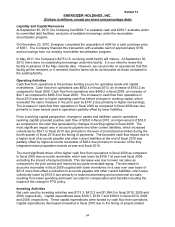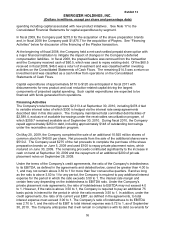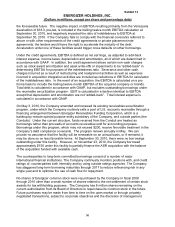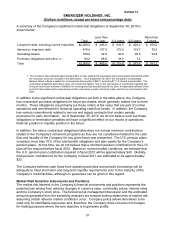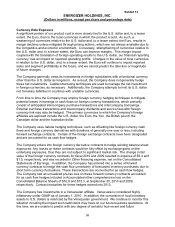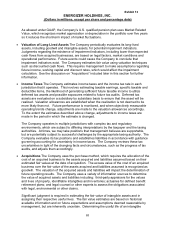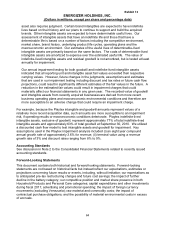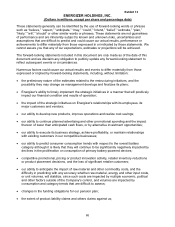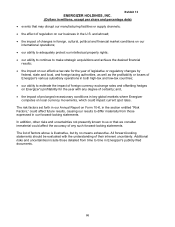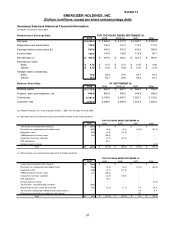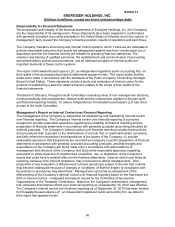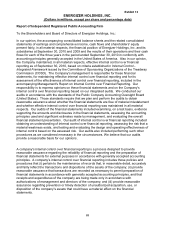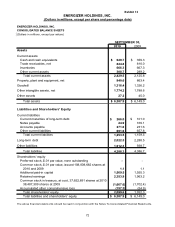Energizer 2010 Annual Report Download - page 74
Download and view the complete annual report
Please find page 74 of the 2010 Energizer annual report below. You can navigate through the pages in the report by either clicking on the pages listed below, or by using the keyword search tool below to find specific information within the annual report.
Exhibit 13
ENERGIZER HOLDINGS, INC.
(Dollars in millions, except per share and percentage data)
64
asset also requires judgment. Certain brand intangibles are expected to have indefinite
lives based on their history and our plans to continue to support and build the acquired
brands. Other intangible assets are expected to have determinable useful lives. Our
assessment of intangible assets that have an indefinite life and those that have a
determinable life is based on a number of factors including the competitive environment,
market share, brand history, underlying product life cycles, operating plans and the
macroeconomic environment. Our estimates of the useful lives of determinable-lived
intangible assets are primarily based on the same factors. The costs of determinable-lived
intangible assets are amortized to expense over the estimated useful life. The value of
indefinite-lived intangible assets and residual goodwill is not amortized, but is tested at least
annually for impairment.
Our annual impairment testing for both goodwill and indefinite-lived intangible assets
indicated that all reporting unit and intangible asset fair values exceeded their respective
carrying values. However, future changes in the judgments, assumptions and estimates
that are used in our impairment testing including discount and tax rates or future cash flow
projections, could result in significantly different estimates of the fair values in the future. A
reduction in the estimated fair values could result in impairment charges that could
materially affect our financial statements in any given year. The recorded value of goodwill
and intangible assets from recently acquired businesses are derived from more recent
business operating plans and macroeconomic environmental conditions and therefore are
more susceptible to an adverse change that could require an impairment charge.
For example, because the Playtex intangible and goodwill amounts represent values of a
relatively more recent acquisition date, such amounts are more susceptible to an impairment
risk, if operating results or macroeconomic conditions deteriorate. Playtex indefinite-lived
intangible assets, exclusive of goodwill, represent approximately 77% of total indefinite-lived
intangible assets and approximately 63% of total goodwill at September 30, 2010. We utilized
a discounted cash flow model to test intangible assets and goodwill for impairment. Key
assumptions used in the Playtex impairment analysis included (i) an eight year compound
annual growth rate of approximately 3.6% for revenue; (ii) terminal value using a revenue
growth rate of 3% and discount rates ranging from 8% to 9%.
Accounting Standards
See discussion in Note 2 to the Consolidated Financial Statements related to recently issued
accounting standards.
Forward-Looking Statements
This document contains both historical and forward-looking statements. Forward-looking
statements are not based on historical facts but instead reflect our expectations, estimates or
projections concerning future results or events, including, without limitation; our expectations as
to anticipated pre-tax restructuring charges and future cost savings; the impact of further
decline in the battery category; our competitive position and market share presence in both
Household Products and Personal Care categories; capital expenditures and other investments
during fiscal 2011; advertising and promotional spending; the impact of foreign currency
movements (excluding Venezuela); raw material and commodity costs; the impact of
contractual purchase obligations; and the possibility of material environmental costs in excess
of accruals.


